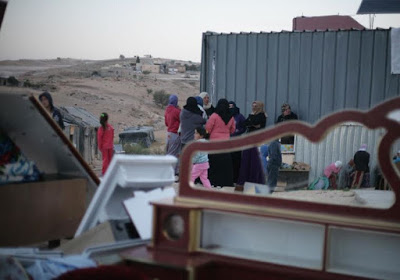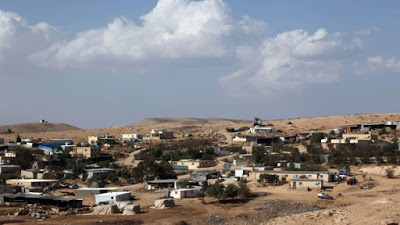This is why Israel is still a settler colonial state
Only in Israel could the state seriously think of
demolishing a village in order to make way for a town containing members of the
ruling (Jewish) ethnicity. That state is
Israel.
demolishing a village in order to make way for a town containing members of the
ruling (Jewish) ethnicity. That state is
Israel.
According
to the Association of the Forty, a Bedouin organisation, there are some 92 ‘unrecognised’
villages in Israel, of which 59 are Bedouins.
Different organisations have different figures but it is accepted that
about half the Arab villages in Israel are unrecognised. Unrecognised villages are not connected to
the national grid, have mains supplied water or any local government services.
to the Association of the Forty, a Bedouin organisation, there are some 92 ‘unrecognised’
villages in Israel, of which 59 are Bedouins.
Different organisations have different figures but it is accepted that
about half the Arab villages in Israel are unrecognised. Unrecognised villages are not connected to
the national grid, have mains supplied water or any local government services.
There are, of course, no unrecognised Jewish settlements in Israel. In fact the Knesset is in the process of
legalising illegal outposts and settlements established on private Palestinian land
in the West Bank. No such initiative is
proposed for the ‘illegal’ (Arabs rarely get planning permission in Israel)
Arab settlements in Israel because it is a Jewish not an Arab state.
legalising illegal outposts and settlements established on private Palestinian land
in the West Bank. No such initiative is
proposed for the ‘illegal’ (Arabs rarely get planning permission in Israel)
Arab settlements in Israel because it is a Jewish not an Arab state.
 |
| Family gathered around their house which was slated for demolition on Tuesday. (photo credit:ELIYAHU KAMISHER) |
Once Umm al—Hiran is demolished, it is proposed to build a
new Jewish town, Hiran, on the ruins.
This is the same process that has gone on in Israel since 1948. Apartheid?
There are some wicked anti-Semites who are willing to defame the Israeli
state by comparing it to South Africa.
However they are wrong. By and
large the Whites of South Africa did not demolish the villages of Black African
villages in order that they could construct White towns and cities on top of
them. They simply excluded Black Africans from sections of different cities under the Group Areas Act.
Tony Greenstein
 |
| Umm al-Hiran. The government has decided to raze the Bedouin village in the Negev to make way for a new Jewish community. Credit: Eliyahu Hershkovitz |
During
the Mandatory Palestine era, the British
authorities were in the process of registering lands in the territory before
the end of the mandate in 1947. They recognised Bedouin ownership of their
land, but the land registration process was incomplete by the time the mandate
was ended. This was taken advantage of by the new Israeli government, which
subsequently refuse to acknowledge traditional Bedouin land ownership customs,
dispossessing thousands. Prior to the 1948 Arab–Israeli War,
the Mandatory Palestine era, the British
authorities were in the process of registering lands in the territory before
the end of the mandate in 1947. They recognised Bedouin ownership of their
land, but the land registration process was incomplete by the time the mandate
was ended. This was taken advantage of by the new Israeli government, which
subsequently refuse to acknowledge traditional Bedouin land ownership customs,
dispossessing thousands. Prior to the 1948 Arab–Israeli War,
Bedouins numbered just
over 90,000 in the Negev, but only 12% remained after the war.[1] The
remaining Bedouin tribes were relocated to the north and north-east of the
district of Beersheba, known as Siyag, which constituted only 7% of the total
district. Lands beyond the Siyag area were designated closed military zones,
barring Bedouins from accessing their original land.[2]
over 90,000 in the Negev, but only 12% remained after the war.[1] The
remaining Bedouin tribes were relocated to the north and north-east of the
district of Beersheba, known as Siyag, which constituted only 7% of the total
district. Lands beyond the Siyag area were designated closed military zones,
barring Bedouins from accessing their original land.[2]
In 1956,
the villagers of Umm al-Hiran submitted a request to return to their original
lands, which was rejected by the Israeli authorities. They were subsequently
moved by a military order to Wadi Atir. From this point onwards, they built
houses from stone and other materials, paved roads, built wells
and farmed the surrounding land. Sheikh Farhoud Abu al Qi’an argued that before their arrival
“It was a desert, with no roads, water, houses or services”.
the villagers of Umm al-Hiran submitted a request to return to their original
lands, which was rejected by the Israeli authorities. They were subsequently
moved by a military order to Wadi Atir. From this point onwards, they built
houses from stone and other materials, paved roads, built wells
and farmed the surrounding land. Sheikh Farhoud Abu al Qi’an argued that before their arrival
“It was a desert, with no roads, water, houses or services”.
In 2001,
the Israel Land Authority described its residents
as a “special obstacle” in its recommendations. In 2003, there was a
state motion to the Magistrates’ Court in Beersheba
for the demolition of the village ex parte, without informing the
landowners; the state claimed that it was unable to identify or reach the
inhabitants.[3] In
2004, the state filed lawsuits in 2004 to evacuate the villagers on the basis
that they were trespassers who were squatting illegally. The court ruled that
the legal status of the residents was as “permanent residents”, but
at the same time concluded that because the land was held from the state free
of charge, their residency could be revoked at any time. The Prime Minister’s Office had also
previously blocked a plan to recognise the neighbouring village of Atir, which
shares land with Umm al-Hiran, requesting instead that the plan did not clash
with the proposal to establish a Jewish town.
the Israel Land Authority described its residents
as a “special obstacle” in its recommendations. In 2003, there was a
state motion to the Magistrates’ Court in Beersheba
for the demolition of the village ex parte, without informing the
landowners; the state claimed that it was unable to identify or reach the
inhabitants.[3] In
2004, the state filed lawsuits in 2004 to evacuate the villagers on the basis
that they were trespassers who were squatting illegally. The court ruled that
the legal status of the residents was as “permanent residents”, but
at the same time concluded that because the land was held from the state free
of charge, their residency could be revoked at any time. The Prime Minister’s Office had also
previously blocked a plan to recognise the neighbouring village of Atir, which
shares land with Umm al-Hiran, requesting instead that the plan did not clash
with the proposal to establish a Jewish town.
The
proposal would relocate the Bedouins of Umm al-Hiran to the Bedouin township of
Hura, one of seven
Bedouin townships,
all of which are at the bottom of the country’s socio-economic index. These
townships are specifically designated towns intended to “contain” expelled
Bedouins. They are characterised by being overcrowded, lacking in adequate
services and having the highest percentage of unemployment
and poverty
in Israel.[4]
proposal would relocate the Bedouins of Umm al-Hiran to the Bedouin township of
Hura, one of seven
Bedouin townships,
all of which are at the bottom of the country’s socio-economic index. These
townships are specifically designated towns intended to “contain” expelled
Bedouins. They are characterised by being overcrowded, lacking in adequate
services and having the highest percentage of unemployment
and poverty
in Israel.[4]
The
authorities are supported by key NGOs, including the Or Movement, which works
to promote the construction of Hiran. Opposition to the plan to forcibly evict
and demolish the village of Umm al-Hiran has come from both non-governmental
organisations and left-leaning MKs. Arab MKs have requested an overall solution
to the Arab and Bedouin housing problem in Israel, including a freeze on all
pending demolition and eviction orders. Ayman Odeh,
the leader of the Joint List, made the housing crisis and treatment of
Bedouins his party’s top priority following the March 2015 elections. Other MKs
have also come out in opposition to the plan, including MK Tamar
Zandberg from Meretz,
who argued “How will we be able to explain how we razed a village… just
because the people belong to a different ethnic or religious group?” Adalah launched a
public campaign entitled “#save_UmmAlHiran”, in order to “stop
Israel’s plan to demolish an Arab Bedouin village in order to build a Jewish
town over its ruins”. The Regional Council of the Unrecognised Villages
has also been active in campaigning to stop the destruction of the village, arguing
the plan amounts to an “ethnic
cleansing” campaign.
authorities are supported by key NGOs, including the Or Movement, which works
to promote the construction of Hiran. Opposition to the plan to forcibly evict
and demolish the village of Umm al-Hiran has come from both non-governmental
organisations and left-leaning MKs. Arab MKs have requested an overall solution
to the Arab and Bedouin housing problem in Israel, including a freeze on all
pending demolition and eviction orders. Ayman Odeh,
the leader of the Joint List, made the housing crisis and treatment of
Bedouins his party’s top priority following the March 2015 elections. Other MKs
have also come out in opposition to the plan, including MK Tamar
Zandberg from Meretz,
who argued “How will we be able to explain how we razed a village… just
because the people belong to a different ethnic or religious group?” Adalah launched a
public campaign entitled “#save_UmmAlHiran”, in order to “stop
Israel’s plan to demolish an Arab Bedouin village in order to build a Jewish
town over its ruins”. The Regional Council of the Unrecognised Villages
has also been active in campaigning to stop the destruction of the village, arguing
the plan amounts to an “ethnic
cleansing” campaign.
Posted in Blog